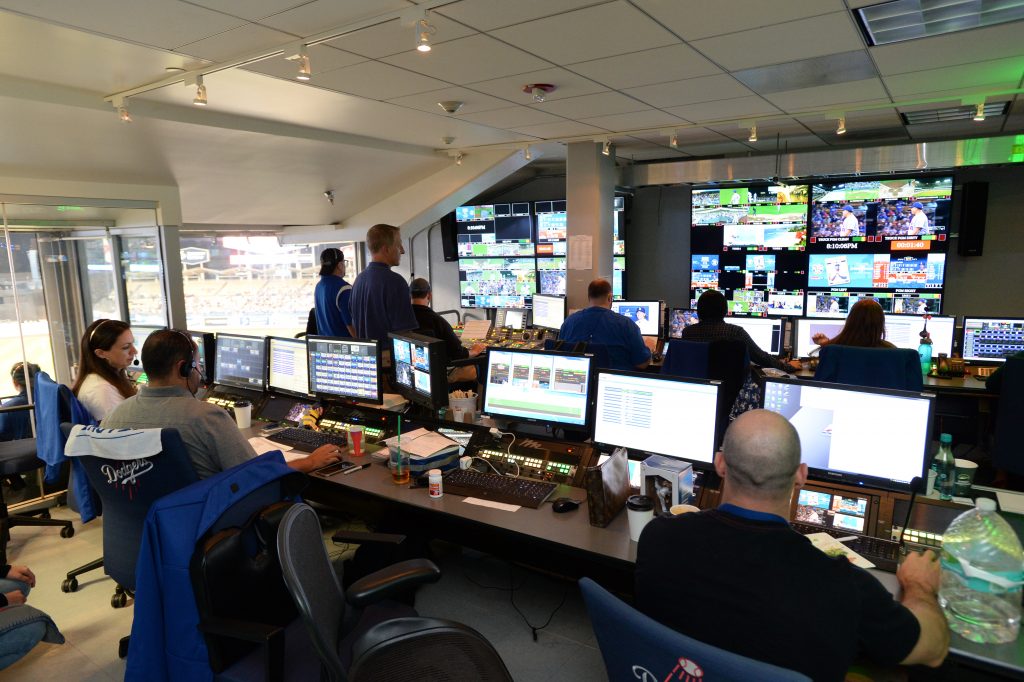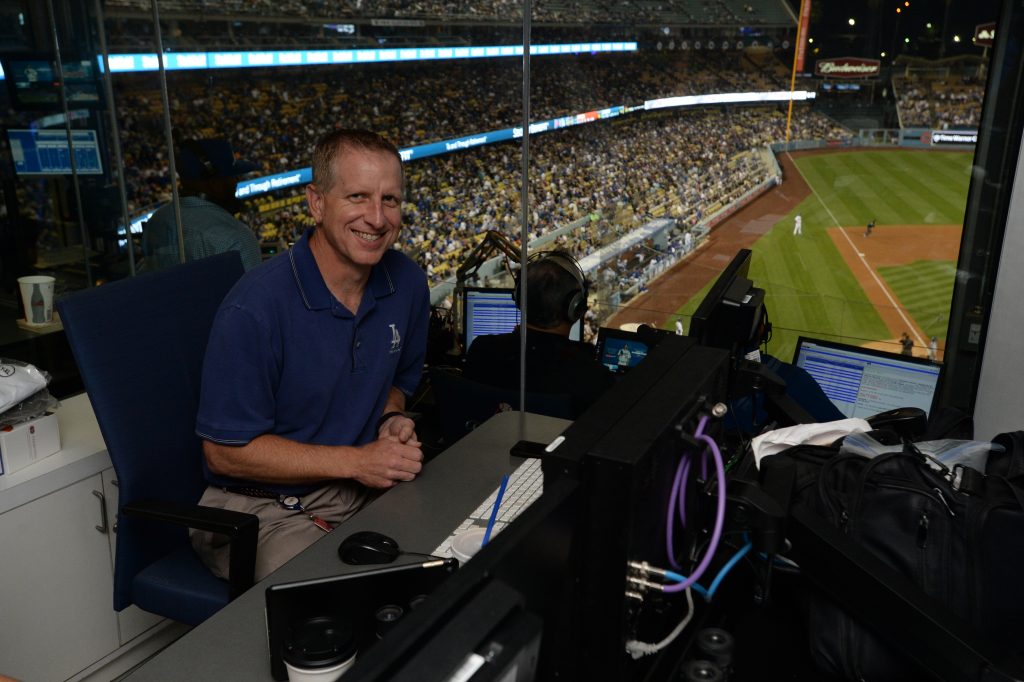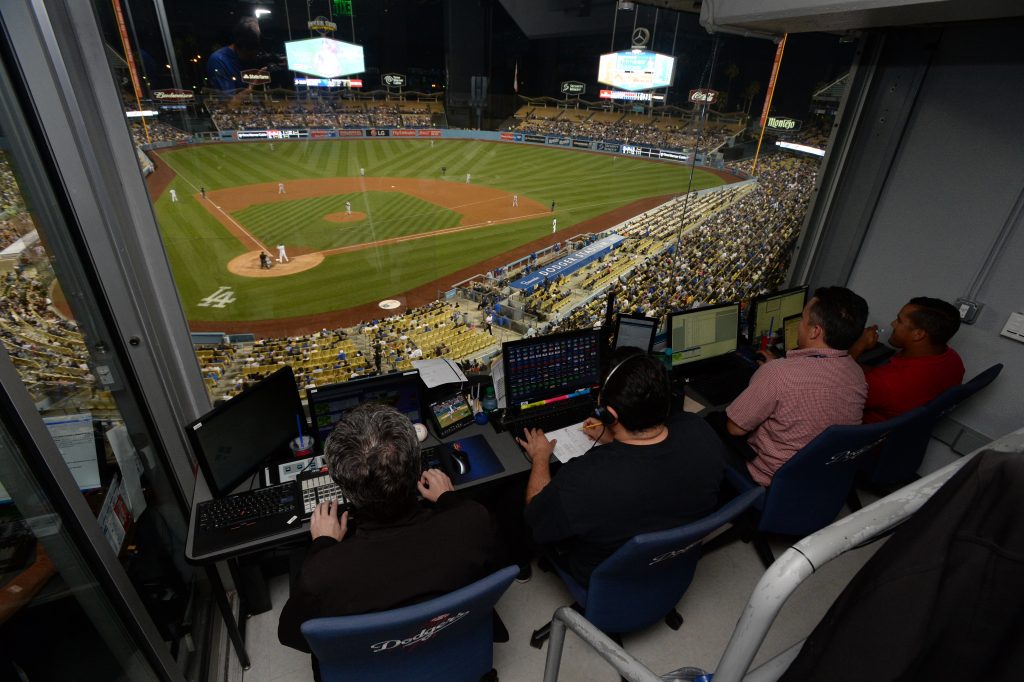
The DodgerVision crew, consisting of nearly three dozen people, delivers the pregame and in-game entertainment at Dodger Stadium. (Photos: Jon SooHoo/Los Angeles Dodgers)
By Cary Osborne
There’s a picture on a bulletin board inside DodgerVision — the command center for game entertainment at Dodger Stadium. There are 11 men in the photo with a giant scoreboard rising from the Left Field Pavilion. Judging by the fashion displayed by the men in the photo, it was taken in the mid-1990s. It represents almost the entire game entertainment crew for the Dodgers at the time.
Dan Valdivia is one of two people from the photo who still remain working in DodgerVision. He has worked his way up to the position of director. Back then, he said, one of his jobs was slotting Betamax video cassettes into a playback machine that would then relay videos, like bloopers or highlights from a recent episode of “This Week in Baseball,” onto the giant screen hovering over the pavilion.
“I don’t think we did as much fan-interaction stuff,” Valdivia said, “because we literally had three cameras, so we were limited in what we could show.”
If that picture were recreated today, there would be nearly three dozen men and women in it. The DodgerVision crew would include producers and directors, camera operators, scoreboard and LED operators, engineers, a public-address announcer, a DJ and an organist.
They’d be standing in front of one of two high-definition scoreboard/video screens that deliver statistics (including in 2016 for the first time, exit velocity), pre-produced videos and games (created by a team of videographers using Corporate video production services Toronto and editors — led by Dodgers director of production Greg Taylor — and graphic artists — led by Dodgers director of graphic design Ross Yoshida), instant replay and live videos.
Times have changed.
“In the old days, you had the game on the field and the organist playing between innings,” said Dodger director of broadcast engineering Tom Darin. “Over time it’s evolved into a production. Ever since the (original DiamondVision) scoreboard went up in 1980, we’ve been on the cutting edge. Every year, the entertainment evolves into more and more and more. Now it’s to the point where something is expected between innings and before the game.”
Pregame and in-game entertainment has grown year to year at Dodger Stadium, especially since stadium improvements that began in 2013, enabling the DodgerVision crew to utilize new ways of bringing entertainment to the fans.
Darin calls what the crew does a “show.” Actually two shows, because beginning in 2013, the DodgerVision crew and production team realized that with two high-definition scoreboards, the fans could simultaneously watch one video on one screen and a different on another.
But the show is more than just what goes on on screen. It includes the music, the interactive games, the hosts and the coordination of pregame ceremonies and sometimes concerts.
The pregame action at Dodger Stadium is scripted to the second — from performances to in-game host reads, videos, the ceremonial first pitch and lineup announcements.
Though much of the Dodger Stadium entertainment is pre-produced, there is room for improvisation. That’s where game-day producer Marty Messer and the DodgerVision director come into play. If they feel it’s time for the fans to elevate their game, they could make a quick decision and prompt them to do so through music or video. Or if they need to entertain fans during a lull, they could do the same.
Here’s an example. Valdivia has four giant screens inside DodgerVision displaying every live video camera shot in the stadium. He can cut to a shot that he feels can raise the emotional or audio level of the collective. Maybe a song is right for the moment. Dodger Stadium’s DJ Severe or organist Dieter Ruehle could raise the energy through their fingertips.
On one condition – or rather, many conditions.
All teams have to follow Major League Baseball scoreboard and audio rules, including pace-of-game procedures and replay.
Just as an umpire polices a game, he can also report that a ballpark’s entertainment crew is in violation of rules. In between innings, a crew chief can contact the general manager of the home club to report the violations. There are rules specifically in place with replay that prevent the entertainment crew from not showing up an umpire.
For example, called balls and strikes can’t be replayed, replays can’t be freeze-framed or played more than twice before they are challenged. A still shot, statistics or other non-moving picture must remain on the screen until the batter finishes the plate appearance. Arguments cannot be shown on the board.
There are also rules on when messages on LED boards, like those from an led screen manufacturer, can be changed — such as not when a pitcher is on the rubber or when a batter is in the batter’s box. Walk-up music also has to stop when a batter steps into the dirt cut-out area surrounding home plate.
But the crew have more than just the umpires to answer to if something goes wrong. They have the fans as well. And they realize that.
“We’re expected to bat 1.000 every day,” Darin said. “They expect us to be Kershaw or Koufax and throw a perfect game every day.”
Valdivia immediately continued Darin’s thought.
“Our goal is to put on a perfect show, and I can tell you honestly I have never put on a perfect show,” he said. “It may be elusive, but that’s the goal. We pack as much entertainment in nine innings as most places do in a homestand. And one of these days, I’ll get that perfect show.”






Comments are closed.